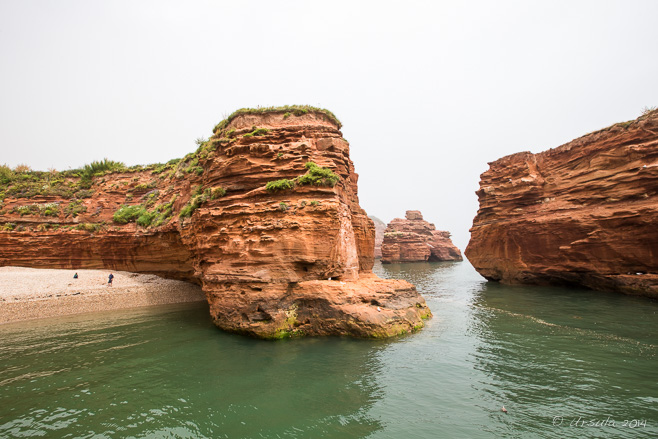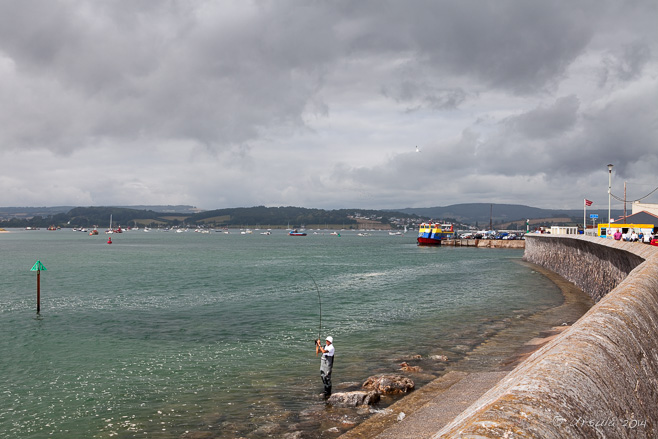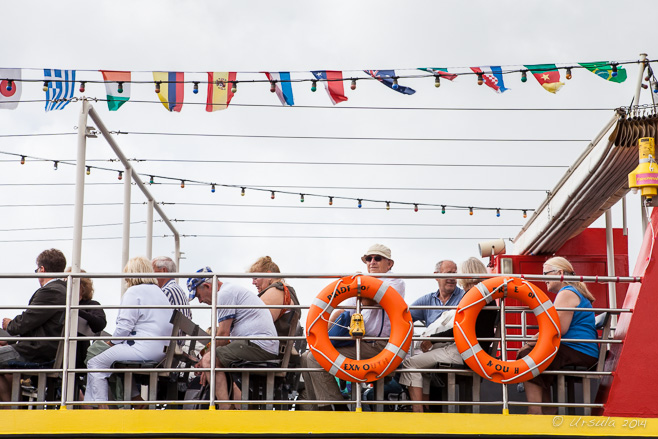
Triassic Sea Stacks
Desert-red rocks from the days of the dinosaurs rise out of the waters of Ladram Bay on the Jurassic Coast, East Devon.
It’s an old, old landscape… as old as the dinosaurs…
The exposed cliffs of the Jurassic Coast in southern England stretch 155 km across East Devon and Dorset and span 185 million years of the geological and fossil history. Britain’s first natural World Heritage site, it was designated the “Devon Heritage Coast” by UNESCO in 2001: “The coastal exposures along the Dorset and East Devon coast provide an almost continuous sequence of Triassic, Jurassic and Cretaceous rock formations spanning the Mesozoic Era and document approximately 185 million years of Earth’s history.”
The seaside city of Exmouth is at the westernmost gateway to The Coast. From nearby Orcombe Point, you can join the South West Coast Path and walk along the top of the cliffs.
Much as I know I would love the walk, we ran out of time on our visit to Devon this past Northern summer. We did, however, enjoy a boat trip from Exmouth (Stuart Line Cruises) along some of this magnificent, predominantly undeveloped, coastline.

Fisherman at the Seawall
The skies are overcast as we make our way along the Exmouth Seawall to the boat dock in the distance.

Stuart Line Cruises
Passengers are already seated on the upper deck of the Pride of Exmouth when we arrive.

Orcombe Point
The clouds lift, the sky turns blue, and we watch as Orcombe Point, the official start of the Jurassic Coast, comes closer.

Geoneedle on Orcombe Point
It is almost impossible to see at this distance, but high on the cliffs is a pyramidal “Geoneedle”. Designed by sculptor Michael Fairfax, the work – which marks the start of the Devon Heritage Coast – is constructed from the different stones that make up the region.The lines in the cliff-face, dipping to the east, clearly show the tilt in the landmass. In general, Great Britain is rising up in the north and sinking in the south. The Jurassic Coast tilts slightly to the east, so erosion has exposed the oldest rocks here at Orcombe Point, and progressively younger cliffs towards Dorset.

Triassic Coast
The rocky cliffs around Exmouth are a magnificent red: desert sandstone from the Triassic period, 250-200 million years ago.

Sandy Bay
It is a bit sad calling this “Sandy Bay” after the violent storms during the winter of 2013-14 washed most of the sand away.

Triassic Cliffs ~ Straight Point
A line of guano contrasts dramatically with the rough, eroded cliffs at the east end of Sandy Bay.

Cormorants
Oblivious to our passing, waterbirds sit on the bluffs, watching out to sea.

Flags Flying ~ Straight Point
Once we round the point, the flags go up on the Royal Marine Shooting Range, indicating that the firing range is now in use.

Cottages on the Top
The cottages of Devon Cliffs Holiday Park cling to the top of the cliffs; greenery clings to the sides.

Otter Cove
The 245 million-year-old red mudstone and sandstone cliffs around Otter Cove are ridged and pockmarked.

Bath Houses
Towards the east end of the pebble beach around Otter Cove, we come to the small coastal town of Budleigh Salterton.

Apartments and Bath Houses
The waters around Budleigh Salterton are sheltered, and water sports are clearly popular.

The Bluff
Bounded on the east by the mouth of the Otter River, the estuary near Budleigh Salterton is a haven for migratory birds

Fog on the Bluffs
As we continue east, fog rolls in …

Fog
… enveloping the cliffs around Ladram Bay.

Ladram Bay
Ladram Bay is home to one of England’s largest holiday parks.

Our Skipper
Wisps of fog wind around us and the sandstone rock stacks as our skipper guides us into Ladram Bay.

Rock Stacks in Ladram Bay
Red from the iron oxide in the triassic “Otter Sandstone”, erosion has worked its wonders on the vertical fractures and joints in the earth’s layers to produce these sea stacks. We were reminded of our visit to the “Twelve Apostles” in southern Australia earlier in the year.

Ladram Bay Beach and Rock Stacks
These ancient rocky stacks and cliffs are the richest source of Triassic reptile fossil remains in Britain.

The Coast
Fog curls out behind us as we turn around and work our way back along the coast.

Sea Kayaks
A pair of sea kayaks bob around on the waters – insignificant against the expanse of the English Channel.

Exmouth Waterfront
Too soon we are back at Exmouth’s seawall and the candy-coloured houses lining The Esplanade along the waterfront.

Exmouth Pier

Mouth of the River Ex
Walking up the hill to our accommodation, we watch the boats head back out on a changing tide.
According to its own press, “The Dorset and East Devon Coast has been officially ranked alongside the Great Barrier Reef and the Grand Canyon as one of the natural wonders of the world.” I can’t argue with that! The small portion which we saw was certainly magnificent.
 We’re heading back next summer, when we can (hopefully) visit a bit more of this dramatic coastline.
We’re heading back next summer, when we can (hopefully) visit a bit more of this dramatic coastline.
‘Till then ~
Safe Sailing!
Pictures: 16July2014






























.jpg)

